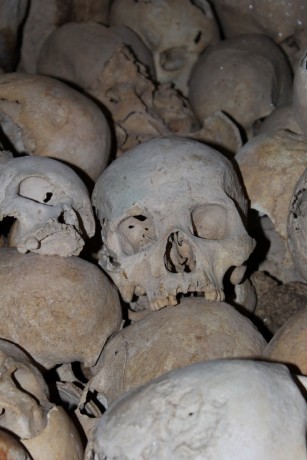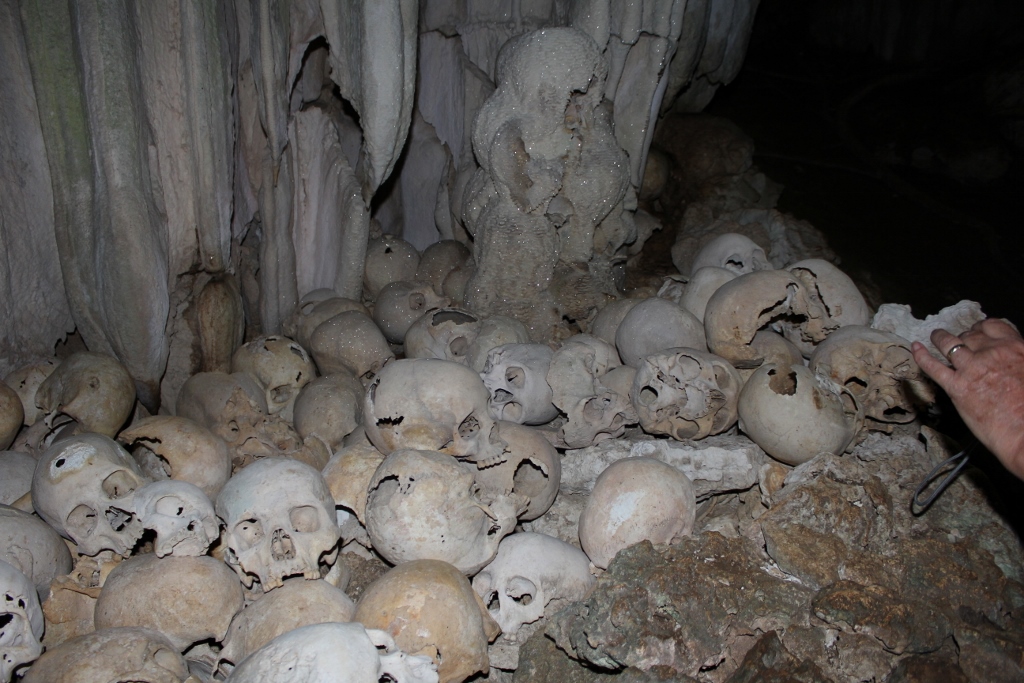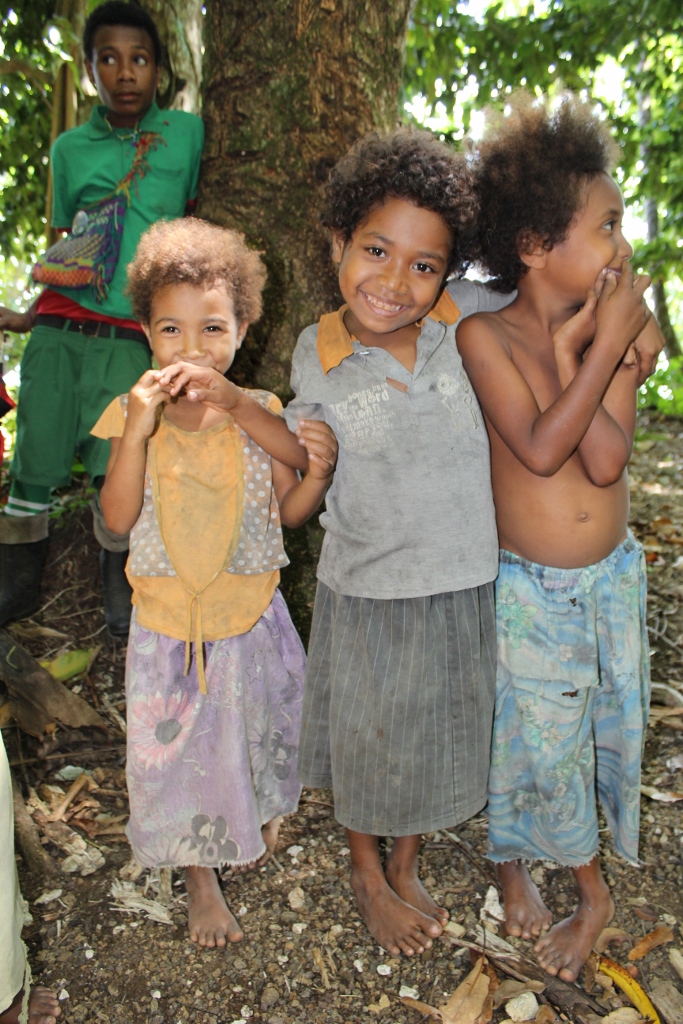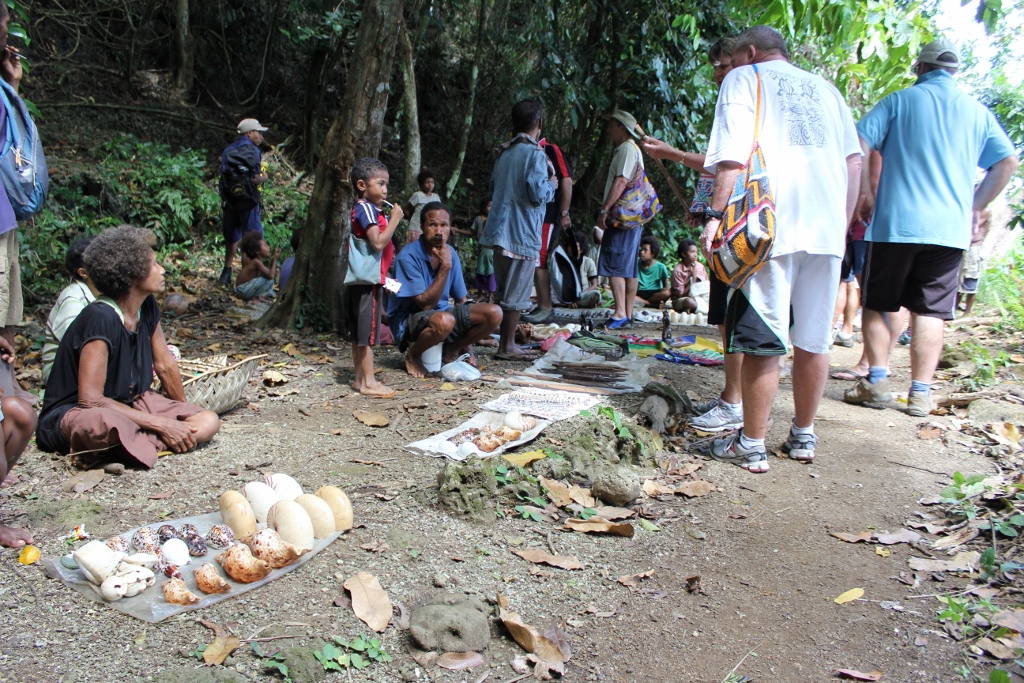The Skull Caves of Milne Bay
This was to be a very exciting day for us; we were to head in the bigger tender up the coast North West, the opposite direction to yesterday to see skull caves. There was an excited air of anticipation amongst us, I certainly had no idea of what to expect, fearing the unknown mixed with an intense curiosity.
We arrived in a picturesque small bay of flat water, with a shingle shore, a small village to the north and a gentle creak running to the south of it, dividing the bay into two sections. The building were of a thatched roof construction, with woven walls and local jungle timber framing. There is no facilities at this place, it has no power, no phone service, no running water, although the locals would argue the creek is that, no road access and everybody had a smile. As our boat pulled into the bay people started to appear from the shade of village, the kids running and laughing in front of the adults who followed at a much more sedate pace.
Transferred in two groups like missionaries or explorers, to the shore standing in a lighter that had followed us to the village, everyone leaped ashore to avoid getting their feet wet.
The kids and some of the adults followed us as we trekked along the foreshore, south-east of the villages towards there treasured tourist attraction.
 Within ten minutes, we were scrambling up towards a ridge line on a narrow track towards a large rocky structure part way up. The jungle is not particularly thick at this point and it felt like a humid Australian bush walk. The entrance to this first cave is unpretentious, with the normal gloom and dampness you expect in places like this. Off to the right, as you move deeper into the cave, it takes a dogleg. At the corner of the dogleg is a pile of cast off old skulls. I do not remember seeing human’s skulls before, especially like this. Just in a haphazard heap they had a grey clay sort of look to them, the view was awe-inspiring. Dealing with this confronting image is different for us all, although most of us revert to humour as a coping mechanism. Someone asked if the locals held these skulls in some sort of reverence, was this a sacred place, is there some sort of respect we must pay. The answer was an emphatic no, these are just skulls that have been here for a long time, they are the heads of our enemies killed eaten and their heads tossed here to keep tally. The more heads you had the bigger the status, was the reply. On close examination of the skulls it’s clear these people did not die of natural causes, every single one of them had one or two holes in the cranium. The guide continued by explaining that the locals would hid in these caves to avoid detection during the day and only venture out during darkness, one imagines searching for new victims to eat. There were no other bones in this cave, just skulls.
Within ten minutes, we were scrambling up towards a ridge line on a narrow track towards a large rocky structure part way up. The jungle is not particularly thick at this point and it felt like a humid Australian bush walk. The entrance to this first cave is unpretentious, with the normal gloom and dampness you expect in places like this. Off to the right, as you move deeper into the cave, it takes a dogleg. At the corner of the dogleg is a pile of cast off old skulls. I do not remember seeing human’s skulls before, especially like this. Just in a haphazard heap they had a grey clay sort of look to them, the view was awe-inspiring. Dealing with this confronting image is different for us all, although most of us revert to humour as a coping mechanism. Someone asked if the locals held these skulls in some sort of reverence, was this a sacred place, is there some sort of respect we must pay. The answer was an emphatic no, these are just skulls that have been here for a long time, they are the heads of our enemies killed eaten and their heads tossed here to keep tally. The more heads you had the bigger the status, was the reply. On close examination of the skulls it’s clear these people did not die of natural causes, every single one of them had one or two holes in the cranium. The guide continued by explaining that the locals would hid in these caves to avoid detection during the day and only venture out during darkness, one imagines searching for new victims to eat. There were no other bones in this cave, just skulls.
 I have since read that there are a number of explanations given for the collecting of skulls in a cave. A popular explanation on the web is the burial caves exist from pre-missionary times when the skulls of important people from the area were kept as a gesture of the respect they were held in. When these people died, they buried them upright with a clay pot over their head, after some time when the head separated from the body; the head then transferred to the cave. Great explanation it maybe and satisfy our western requirement for everything in the world to be romantic and nice, the fact is every skull I examined had at least one hole in it. Someone bashed these guys or girls in the head, it’s unbelievable they were any revered locals, the disrespect the locals had for these tourist artefacts adds weight to our guide’s explanation.
I have since read that there are a number of explanations given for the collecting of skulls in a cave. A popular explanation on the web is the burial caves exist from pre-missionary times when the skulls of important people from the area were kept as a gesture of the respect they were held in. When these people died, they buried them upright with a clay pot over their head, after some time when the head separated from the body; the head then transferred to the cave. Great explanation it maybe and satisfy our western requirement for everything in the world to be romantic and nice, the fact is every skull I examined had at least one hole in it. Someone bashed these guys or girls in the head, it’s unbelievable they were any revered locals, the disrespect the locals had for these tourist artefacts adds weight to our guide’s explanation.
He did however relate the story of a white man who unfortunately ended up in the jungle and had to flee; in his flight, he lost a shoe. The locals found the shoe, thought it was a foot, cooked, and eat it. It was a bit leathery and not very nice, thus they decided ‘man bilong longwe ples’ (foreigner) was not a good feed. Hummm not convinced on that, one sounds a bit like a jungle myth for gullible city slicker white tourists. Never mind its probably better there is mystery around it.
The small cave is spectacular in its own right, with stalactites reaching to the floor and a glittering sparkle in the limestone walls; this is the backdrop to the skulls heaped in a bowl of rocks. We had sufficient room to gather around the skulls; those of us who did not have a moral dilemma with touching human remains were able to handle the skulls, which resulted in some interesting photography. The skulls themselves had a limestone feel about them and many sparkled as decades of dripping limestone-impregnated water had calcified them.
We left this cave and headed back down the hill to a second cave, the magic of the jungle had been alive while we were in the cave as a row of stalls had appeared with smiling faced vendors selling carvings, shells and artefacts had sprung up in groups along the way. Bunches of kids fascinated with us guys were willing to line up to have their photograph taken, also queuing up for the lollipops a number our team had brought with them,
 The next cave is back towards the village not far off the track, another small clutch of instant vendors was outside the entrance with a wonderful array of shells, woven goods and very good carvings. The locals were sitting on the jungle floor cross-legged laid with their goods neatly laid out on a variety of old plastic bags and clothes.
The next cave is back towards the village not far off the track, another small clutch of instant vendors was outside the entrance with a wonderful array of shells, woven goods and very good carvings. The locals were sitting on the jungle floor cross-legged laid with their goods neatly laid out on a variety of old plastic bags and clothes.
We had to climb on a ledge at the back of this gloomier cave and through a small gap into secondary chambers; we could see by the light of our cheap locally purchased torches heaps of skulls. I didn’t get as close to these and could not be sure they too had skull wounds, but there was a lot of them.
We left the caves in a little more sombre mood than we had arrived, after gifting our cheap local torches to the local kids we head back to the village to have a look at a local waterfall.





Pingback:Jungle Village and Waterfall - Good Old Chinwagging